
Offers a clear and concise overview of the latest theories and research on the causes and control of delinquency. The text is organized around three major questions: What is the nature and extent of delinquency? What are the causes of delinquency? What strategies should we employ to control delinquency? Compared to other textbooks on the market, this book is written in a more conversational style. And compared to other textbooks, this book is more focused. Other textbooks attempt to cover all the major theories and areas of research at the risk of confusing and overwhelming students. In contrast, Agnew's Juvenile Delinquincy is more student and instructor friendly in its approach. For instance, rather than covering all the major theories (and numerous versions of each theory), Agnew synthesizes the best of current delinquency theories into “generic” theories representing strain, social learning, control, and labeling theories. The book then show how these theories can be used to interpret research on the causes of delinquency. In addition, the book promotes active learning. Agnew poses questions for students throughout the text and encourage them to apply the text materials to their own lives. This emphasis on application dramatically increases the students' understanding of the materials. Finally, Juvenile Delinquincy describes how criminologists know what they know. Students, then, are not asked to accept the findings of criminology on faith. They are given a sense of what the research process is like.